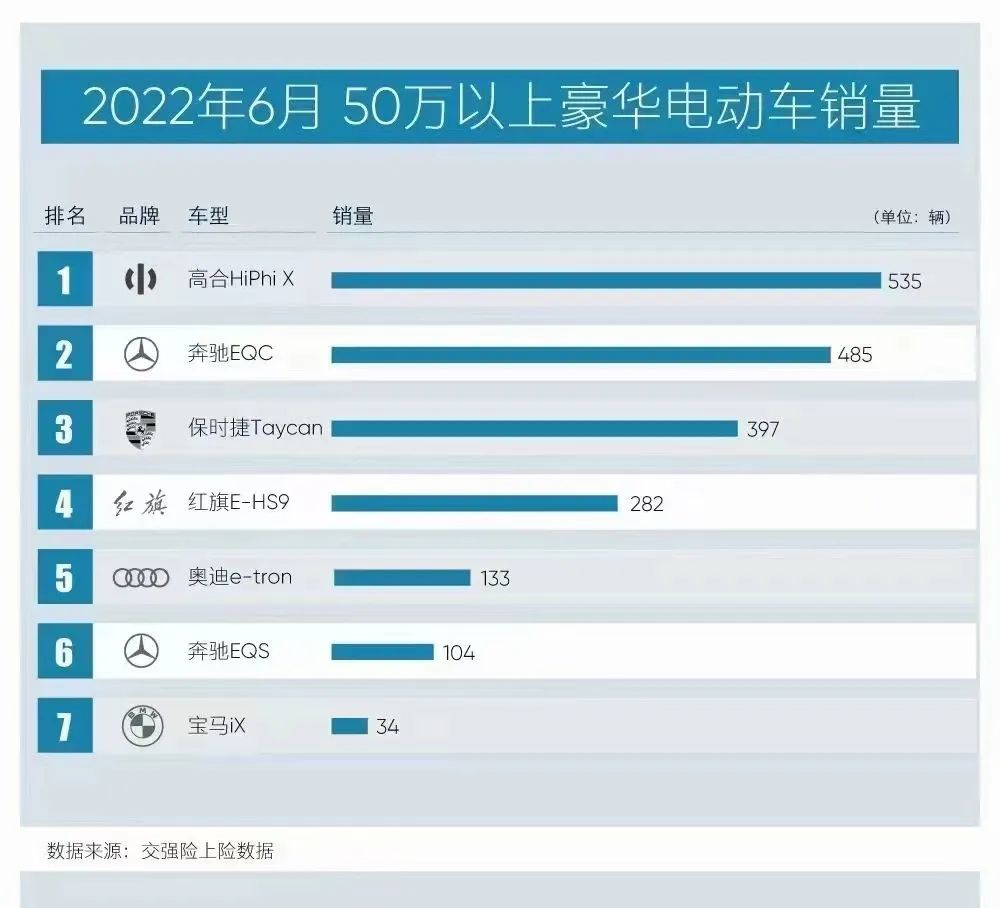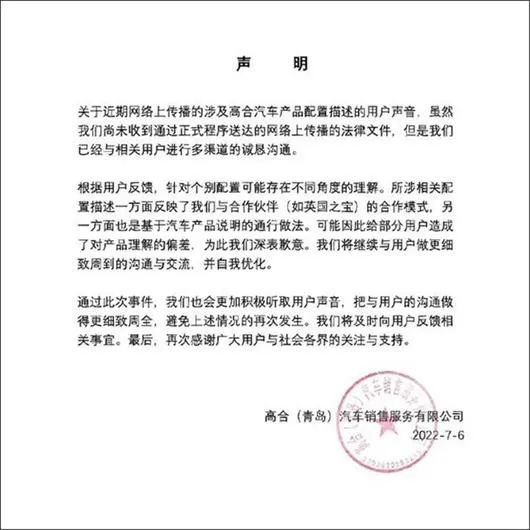Author: Su Qin, Feng Jingang
Born with controversy, the new force in carmaking is destined to take a bumpy road of development with its head down and then amaze everyone. Over the past three years, Ding Lei’s GAC Aion has followed such a development strategy and has also achieved good results.
In the Chinese market, the GAC HiPhi X beat a group of top players such as the Porsche Taycan, leading the sales crown of high-end pure electric vehicles priced above 500,000 yuan. This is a glory that has never been seen before in the Chinese automobile industry.

However, recently, the critical point of this head-down development strategy has been broken. A mysterious “false advertising incident” has dragged the GAC, which had been focusing on private domain development, into the public spotlight.
A Comedy
On July 5th, GAC held a product briefing for its second car, HiPhi Z. At the time, what GAC did not expect was that a storm regarding the first car, HiPhi X, was brewing.
Starting from July 6th, a lawyer’s letter accusing GAC of false advertising regarding HiPhi X, signed by 50 HiPhi X car owners, was widely spread on a certain platform. According to the letter, these 50 car owners believed that there were discrepancies between the British Treasure sound system, semi-phenylamine interior, and power battery capacity of HiPhi X and its promotion, so they demanded GAC to execute a “triple compensation for falsehood.”
One day GAC launches a new car, and the next day it is caught up in a false advertising scandal. Is this an unintended coincidence or an intentional rhythm? Regardless of which one, it is inevitable that everyone would start to speculate. According to our research, this incident had already been reported online on July 1st.
There is also this very suspicious lawyer’s letter that gave people the illusion that GAC has been nailed for false advertising, leading to the event escalating again.
Given the impact of the incident and to protect the brand reputation, GAC released a statement on the evening of July 6th:

GAC’s statement has several implications. Firstly, it has not yet received this lawyer’s letter, implying that the authenticity is dubious, and it is far from being confirmed as false advertising. Secondly, the so-called false advertising of the product is only caused by a misunderstanding of the interpretation. Thirdly, GAC regrets the misunderstanding caused to users and will reflect on and improve it.
Generally speaking, during the excitement of a new car release, car companies would strongly refute such incidents. However, GAC’s statement does not show any sign of hostility but instead shows some tenderness, such as the use of phrases like “deeply apologize” and “self-improvement” in the second paragraph. What is the logic behind this? We will elaborate on this in the following paragraphs.However, many media outlets found Geely’s statement to be “incomprehensible,” which appears to be at odds with expectations. This time, some netizens accused Geely of playing word games.
The combination of these two issues puts Geely in a difficult position, as the hat of false advertising seems to be getting tighter and tighter. However, when we carefully analyze the before and after events, we find many doubts:
For instance, the source of this lawyer’s letter is unknown, and many reports have cited “some netizens” as the source, making it impossible to determine who that netizen is. Moreover, 50 car owners remain silent, and more than 99% of other car owners have not been supportive. The three allegations against Geely’s false advertising are difficult to substantiate.
Sure enough, on July 13th, the situation turned around. Jiangsu Hongxie Law Firm, which drafted the aforementioned lawyer’s letter, issued a statement clarifying that the letter had not been delivered to Geely and that no legal proceeding had begun. A lawyer’s letter that has not entered the legal process has no legal basis, which means that the charge against Geely for false advertising is wholly unfounded. In the end, this incident turned out to be a farce.
Looking back at Geely’s statement, if Geely were an ordinary car company, it would be feasible to make a strong statement and severely denounce the lawyer’s letter, especially during a critical time of new car launches. But why didn’t Geely do that?
Geely doesn’t shirk responsibility and deserves trust instead.
After the news spread, many netizens ridiculed Geely for “targeting the rich,” but the truth may be quite the opposite.
Let’s go back to the three issues raised by the 50 users: the Bowers & Wilkins audio brand, Semi-aniline leather, and the discrepancy between the advertised and actual power battery capacities of HiPhi X. In their view, Geely is suspected of fraudulent sales. But is Geely really suspected of such practices?
A close examination of these three issues reveals flaws:
For example, with regards to the second point, some car owners found that some of the seats are made of semi-aniline leather, which contradicts Geely’s advertising. Although there is a suspicion of exaggeration, it does not seem to be illegal. As for the third issue, the difference between total installed battery capacity and available battery capacity is a universal industry standard in battery design.
As for the controversial “Bowers & Wilkins” incident, it is indeed a common practice in the audio industry. In this regard, Li Xiang, the CEO of Ideal Cars who likes to gossip, has provided a detailed explanation:#### Premium Car Audio Brands and their Role in Automotive Industry
Several well-known high-end car audio brands are commonly found in luxury vehicles today, with prices reaching tens of thousands of yuan as optional upgrades. Most of these brands do not produce speakers, amplifiers, or even software for audio systems. Their main role is tuning (a skill highly valued by top-level brands) and many of them don’t even handle the tuning themselves, instead opting for licensing deals.
In response to these concerns, Gaoh合(Gaohe) has made statements clarifying that the main cause of the “British Treasure” incident was a misunderstanding between the company and customers. Although Gaoh合(Gaohe) has not completely distanced itself from the incident, the company has proactively communicated and worked to resolve the issue.
For example, the phrases used in the first paragraph of Gaoh合(Gaohe)’s statement, such as “multichannel” and “sincere communication”, and in the second paragraph such as “apologize sincerely”, “communication and exchange in a more thorough and considerate way”, and “self-optimization”. The third paragraph emphasizes “actively listening to customer feedback” and “communication being more thorough and comprehensive”, all of which demonstrate Gaoh合(Gaohe)’s attitude.
Conflicts between customers and car companies are not uncommon in the industry, but the attitude of most car companies is usually indifferent. In the case of this incident, Gaoh合(Gaohe) has shown a different approach by not relying solely on legal arguments or a cold-blooded response, but instead reflecting on its own shortcomings and hoping to win over customers with warmth and care.
If Gaoh合(Gaohe) had responded in a harsh and cold-blooded tone and denied its responsibilities, it might have won a legal victory, but would have lost in the court of public opinion, and more importantly, lost the trust of its current and potential users. Who would be enthusiastic about a brand that refuses to take responsibility?
After the incident, the 50 car owners involved did not publicly confront Gaoh合(Gaohe), and the overwhelming majority of its more than 6,000 users did not follow suit in urging the company. This shows that the vast majority of customers understand the issues raised and are satisfied with the communication between Gaoh合(Gaohe) and its users.
Although this incident initially appeared to damage Gaoh合(Gaohe)’s brand reputation, it actually created more loyal users and potential customers in the long term. A responsible brand that is willing to communicate openly after an incident is one that is hard to refuse.
According to point 4 of the statement released on July 13th by Jiangsu Hongxie Law Firm, the plaintiffs (50 car owners) expressed their willingness to continue supporting Chinese domestic brands in practical ways. They hope that Gaoh合(Gaohe) will continue to create high-quality automotive products and services, and strive towards higher, farther and stronger performance.
Electric Impulse has Something to SayIn 2014, China’s new forces in car manufacturing began to rise on the historical stage. Despite being criticized along the way, they never gave up their determination and exploration for the future. They focused on development, starting from scratch to attract users, and expanding the market step by step. With their passion and hard work, they gradually established a foothold in the industry.
Of course, whether it is the independent brands of the past or the new forces of the present, they will face various troubles in their growth. For example, the recent trouble with GAC is ultimately due to differences in understanding between both sides. Therefore, at this time, can we give GAC more understanding and tolerance first? Secondly, this incident clearly cannot withstand scrutiny. So before spreading it widely, can we first clarify the situation?
In the decisive battle of whether China’s automobile industry can completely stand up in the field of new energy vehicles, the new forces are currently performing better as a whole than the independent brands, especially with the successive breakthroughs of GAC, NIO, and IDEAL in the high-end market. Although their sales figures may not be as dazzling as traditional high-end brands like BBA, their impact on these established carmakers is real.
If Chinese high-end car brands compete to rise, it will not only benefit Chinese consumers, but also the entire Chinese automobile industry!
This article is a translation by ChatGPT of a Chinese report from 42HOW. If you have any questions about it, please email bd@42how.com.
